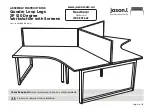
Power supply requirements
The design requires plus and minus 15V supplies. The power supply should be adequately
regulated. The current consumption is about +40mA for the +15V rail and -35mA for the
-15V rail. Power is routed onto the PCB by a four way 0.156” MTA156 type connector or the
special five way Synthesizers.com MTA100 header.
Power connections – MOTM and Oakley
The PSU power socket is 0.156” MTA 4-way header. This system is compatible with MOTM.
Power
Pin number
+15V
1
Module GND
2
Earth/PAN
3
-15V
4
The earth/pan connection has been provided to allow the ground tags of the jack sockets to be
connected to the powers supply ground without using the module’s 0V supply. Earth loops
cannot occur through patch leads this way, although screening is maintained. Of course, this
can only work if all your modules follow this principle.
Power connections – Synthesizers.com
The PWR power socket is to be fitted if you are using the module with a Synthesizers.com
system. In this case the PSU header is not fitted. The PWR header is a six way 0.1” MTA, but
with the pin that is in location 2 removed. In this way location 3 is actually pin 2 on my
schematic, location 4 is actually pin 5 and so on.
Power
Location number
Schematic Pin number
+15V
1
1
Missing Pin
2
+5V
3
2
Module GND
4
3
-15V
5
4
Not connected
6
5
+5V is not used on this module, so location 3 (pin 2) is not actually connected to anything on
the PCB.
If the PWR header is fitted then pins 2 and 3 of PSU are linked together. This connects the
panel ground with the module ground.
7





























